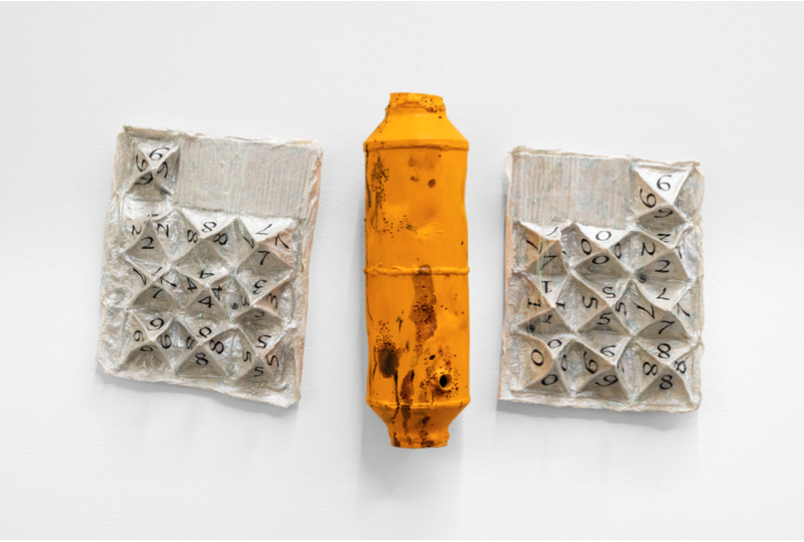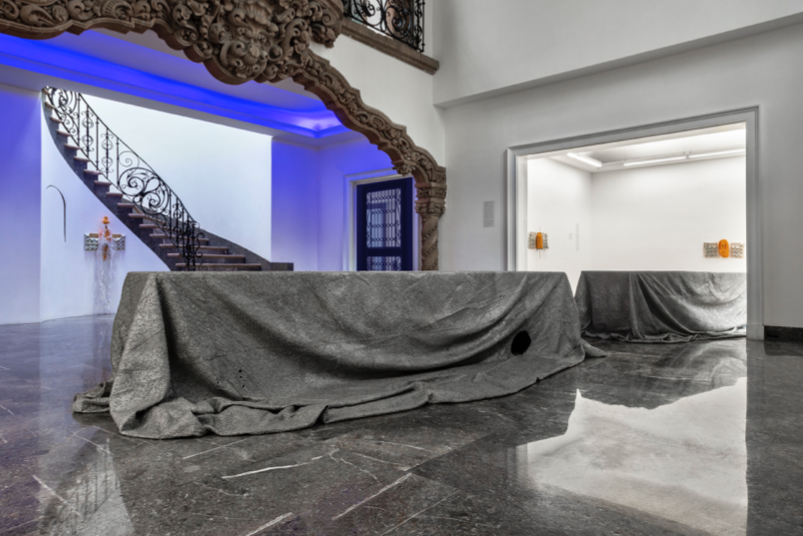
- Source: CARLA
- Author: Lee Purvey
- Date: November 2023
- Format: PRINT
(L.A. in Mexico City) Nancy Lupo at Morán Morán
June 14–August 26, 2023
There’s a scene at the beginning of the novel Leaving the Atocha Station (2011) in which Ben Lerner’s protagonist follows a stranger through Madrid’s Prado Museum, watching as he bursts into passionate tears in front of one masterpiece after another. Is this man grieving, the narrator wonders, or is he just “having a profound experience of art?”1 The scene is funny because it identifies something we’ve all experienced—namely, the jarring disjunction between the ceremony and reverence with which art is treated in the gallery or museum context and the reality of how it actually makes us feel. We should be moved by art, we are implicitly told—provoked, confounded, inspired. If no such powerful emotional or intellectual response immediately emerges, such thinking goes, then there’s either something wrong with us or something wrong with the work.
Philosopher Alva Noë debunks this notion, arguing that effort is fundamental to the aesthetic experience. In his book, The Entanglement: How Art and Philosophy Make Us What We Are (2023), Noë proposes that works of art—and aesthetic phenomena generally—should not be characterized by their beauty or meaning but by their inscrutability. “The art object, in its purest form, is something that we don’t recognize,” he writes. Rather than serving as “stimuli that trigger a special kind of episode in the consciousness” (think: Lerner’s overwrought museum patron), works of art actively challenge the viewer, demanding participation in the creation of their content and meaning. The “aesthetic blind,” as Noë terms it, refers to this very opacity, to the necessity of our “effortful movement from seeing to seeing differently.” In short, rather than a task of analysis or evaluation, engaging with an artwork is a practice, a matter of how we orient ourselves toward the world.
It is just such a process that informs the conceptual work of Nancy Lupo, whose show Max Payday recently closed at Morán Morán’s Mexico City gallery. Accompanying the show’s new sculptural and video work was a series of diaristic meditations installed throughout the gallery as wall texts chronicling the months and years leading up to the show’s creation. Comprising a free-associative constellation of Lupo’s entanglements with the people, events, and (especially) objects dotting the show’s circuitous gestation, the text described what we might consider her own attempts at “seeing differently,” offering a generous entry point for the viewer to embark on a similar practice.
While it’s not uncommon for wall texts to provide context for works on view, Lupo pushed this function to its extreme, offering thousands of words in a stream-of-consciousness deadpan reminiscent of auto-fiction writers like Lerner, Sheila Heti, and Tao Lin. Though, while Lupo has a strong presence in this text, its real protagonists were a series of objects: the artist’s 1998 Chevy S-10; her Percival Lafer sofa; a gold chain of dubious provenance; the suburban home belonging to Lupo’s parents, where the artist goes to deposit carloads of studio ephemera. In her writing, Lupo carefully considers all of these objects alongside countless others, candidly documenting the process by which they informed and,in some cases, became literally integrated into the artworks in the gallery.

Nancy Lupo, Colorado Royalty (2023).
Oil on catalytic converter shell, toilet paper, PVA, pearl pigments, phosphorescent pigments, Balsa wood, paper, and fly fishing line,
17 × 29.5 × 5.5 inches. Image courtesy of the artist and Morán Morán. Photo: Gerardo Lando.

Nancy Lupo, Max Payday (installation view) (2023). Image courtesy of the artist and Morán Morán. Photo: Gerardo Lando.
Max Payday was anchored by a series of tellers sculptures. Lupo has been exploring this form for several years, inspired by the origami fortune tellers found in many an elementary school classroom. In Lupo’s interpretation, these objects’ numbered folds are stitched together to form egg carton-like topographies made of toilet paper, pigment, fly fishing line, and glue, among other materials. Each teller’s 10 pyramidal peaks bore the cell phone numbers of Lupo’s friends, lending an unexpected literality to these whimsical works. At Morán Morán, these rectangular assemblages hung on the walls in pairs, flanking catalytic converter shells painted mango yellow—the shells are vaguely reminiscent of featureless skulls, a quality accentuated by the eerie metal crown perched atop I think they should be low, I mean we are guilty of it too. (2023). These salvaged auto components are a dramatic centerpiece in Lupo’s exhibition text: The theft of a catalytic converter from the artist’s pickup and her meticulously inventoried efforts to repair it take up substantial space across her writings. This Homeric quest generates over 1,400 words that eventually achieve a poetic, vaguely occult register: “Not blunted, just melancholic, the leaves are falling and I’m trying to read the leaves and understand what it all means.”
This desperate need to interpret a chaotic present, to attune to some hidden higher order, serves as a central theme across the exhibition—one neatly encapsulated in the form of the fortune teller. The faux gold chain referenced in Lupo’s writings dangled from one of these wall-mounted triptychs, I’m all about houses. (2023). In a humorous digression, Lupo recounted discovering the chain—which bears an enticing “14k” stamp on its clasp—while hiking in Runyon Canyon the day after her catalytic converter was stolen, an event she interpreted as proof that “the universe wants to set it all right.” She wore the chain with covetous reverence for weeks before finally discovering that it was a fake.
Lupo imbued the gallery space with the same searching, magical quality that her text conveys through clever modifications to Morán Morán’s colonial-style building. Tiny round cuts into the gallery’s drywall allowed patterns of light and moving air to pour into the exhibition space, drawing attention to a physical infrastructure that so often goes overlooked. Elsewhere, small offerings of beetles, snakeskin, and cast replicas of thorns populated the nooks and crannies of the usually tidy white cube. While gesturing, like Lupo’s esoteric wall text, toward concealed undercurrents of cause and meaning, these interventions also served to physically and temporally ground the viewer in the art encounter, laying bare the process of looking and discovery.
Lupo’s meditations upon these objects and phenomena illustrate Noë’s conception of the aesthetic encounter: “Art demands that we move beyond the familiar, engrained ways of looking, thinking, acting, or more generally, being, that constrain us and, in so many ways, hold us captive. Whether we’re considering a Chevy pickup truck or a blank gallery wall, Lupo’s art promises an opportunity to see differently. Yet, for all its words spent, Max Payday ultimately asks far more than it answers. As Noë suggests, this kind of aesthetic practice—one that engages with objects without a clear directive—does not yield knowledge of the usual sort; it has little interest in solutions, meaning, or even beauty. Like that of the gallery visitor, its task is never finished, its answers ever provisional. What matters is that it bothers to ask in the first place.

